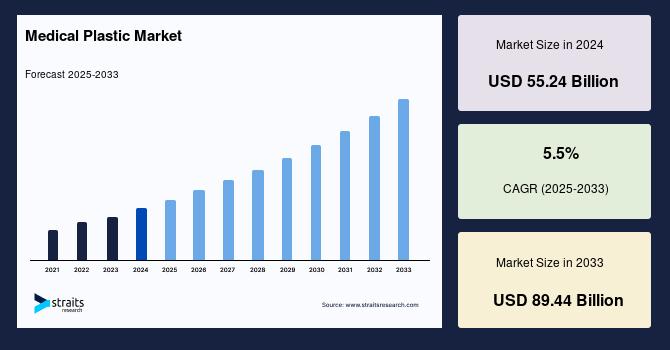Medical Plastic Market: Transforming Healthcare with Precision and Innovation

The global medical plastic market size was valued at USD 55.24 billion in 2024 and is projected to reach from USD 58.28 billion in 2025 to USD 89.44 billion by 2033, growing at a CAGR of 5.5% during the forecast period (2025-2033).
Versatility and Advantages of Medical Plastics
Medical plastics are specialized polymer materials designed to meet stringent requirements for safety, durability, and sterilization resistance in medical environments. These materials, including medical-grade polypropylene, polycarbonate, and silicone, offer unique advantages such as resistance to heat, chemicals, and bodily fluids while maintaining biocompatibility. As a result, medical plastics are well-suited for repeated sterilization cycles and critical medical applications, ranging from MRI casings and surgical devices to diagnostic tools, packaging, and disposables like syringes and IV bags.
The shift from traditional materials like steel, glass, and ceramics toward plastics is driven by plastics' lower cost, lighter weight, and superior adaptability. The ability to produce single-use products enhances hygiene and prevents cross-contamination, which has become especially vital in the wake of global health challenges like the COVID-19 pandemic, further boosting demand.
Key Market Drivers
Several factors propel the medical plastics market's expansive growth. Firstly, the aging global population, particularly in developed regions, fuels demand for medical devices, implants, and pharmaceutical packaging. For example, North America, the largest regional market, benefits from increased healthcare spending and an aging population requiring advanced medical care solutions. Healthcare infrastructure investments and expanding insurance coverage further stimulate demand for medical devices and related plastic components.
The Asia-Pacific region is the fastest-growing market segment, projected to reach nearly USD 15.9 billion by 2030 with an anticipated CAGR of 8.7%. Rising consumer wealth coupled with increasing hospital safety standards and expanding medical tourism in countries like China and India are driving the demand for high-quality medical plastics in this region.
The COVID-19 pandemic has also played a crucial role by accentuating the need for medical bags, masks, gloves, syringes, ventilation systems, and other protective and diagnostic equipment made from plastics. This surge in healthcare demand across affected countries in Asia-Pacific further catalyzed market growth.
Regional Market Dynamics
-
North America dominates the global landscape due to a robust healthcare system, advanced regulations, and continuous innovation in polymer applications for medical devices. The region’s medical plastic market growth is supported by high per capita healthcare spending and policies favoring advanced, sterile medical products. The United States particularly commands a commanding share within this market.
-
Asia-Pacific, as the fastest-growing market, benefits from expanding healthcare infrastructure, rising disposable incomes, and increased focus on healthcare quality and safety. The region’s emphasis on hospital upgrades and medical tourism has amplified demand for diverse applications, from wound care to mobility aids.
-
Europe holds the second-largest share, with growth driven by the adoption of plastics in surgical implants, prosthetics, diagnostic equipment, and pharmaceutical packaging. However, stringent regulations under various EU directives concerning medical devices can increase production costs and pose challenges for smaller manufacturers.
Application Segments
The medical plastics market is segmented by type and application, reflecting diverse uses and material technologies:
-
Commodity Plastics such as polypropylene, PVC, polyethylene, and polystyrene account for the largest market share, primarily due to their widespread use in disposable medical items and packaging. These materials are valued for cost-effectiveness and dependability across various medical devices.
-
Engineering Plastics, including polycarbonate and polyetheretherketone (PEEK), form the fastest-growing segment. Their superior mechanical properties, chemical resistance, and biocompatibility enable use in advanced surgical instruments, implants, and dental materials such as denture bases.
-
Silicone Medical Plastics are gaining traction due to biocompatibility and application in implantable devices such as heart pumps, reconstructive surgery components, and other critical medical equipment. These plastics also find use in keypad covers for diagnostic machines.
In terms of applications, medical components dominate, comprising items such as catheters, containers, surgical instruments, and syringes. This segment is expected to grow robustly, reflecting the increasing demand for medical consumables. Meanwhile, medical device packaging holds significant share due to the rising chronic disease burden and demand for portable, sterile packaging solutions primarily made from PVC.
Mobility aids, such as wheelchairs and bath seats, are another growing area where plastics replace metal parts, favored for their strength and fatigue resistance, especially engineering plastics.
Challenges and Environmental Considerations
Despite the promising outlook, the medical plastics market faces challenges, including stringent regulatory environments, especially in Europe, which may limit innovation and impose high compliance costs. Furthermore, environmental concerns over plastic waste have prompted industry efforts toward recycling and sustainability initiatives.
Manufacturers and policymakers are increasingly cooperating to address the post-use lifecycle of medical plastics through extended producer responsibility (EPR) programs, recycling campaigns, and innovation in sterilization techniques to reduce disposable plastic consumption while maintaining hygiene and safety.
Conclusion
The medical plastics market is poised for dynamic growth driven by demographic trends, technological advances, and evolving healthcare needs globally. Its ability to provide cost-effective, versatile, and safe materials for critical medical applications continues to transform patient care and medical device manufacturing. As regions like Asia-Pacific expand healthcare infrastructure and North America sustains demand through innovation, the medical plastics sector is set to play a pivotal role in shaping the future of medical technology and healthcare delivery worldwide.
This growth trajectory, coupled with increasing regulatory focus on quality and environmental sustainability, will ensure the medical plastics industry remains at the forefront of healthcare advancements in the coming decade.
- Art
- Causes
- Crafts
- Dance
- Drinks
- Film
- Fitness
- Food
- Παιχνίδια
- Gardening
- Health
- Κεντρική Σελίδα
- Literature
- Music
- Networking
- άλλο
- Party
- Religion
- Shopping
- Sports
- Theater
- Wellness



